8 Effective Leak Detection Methods
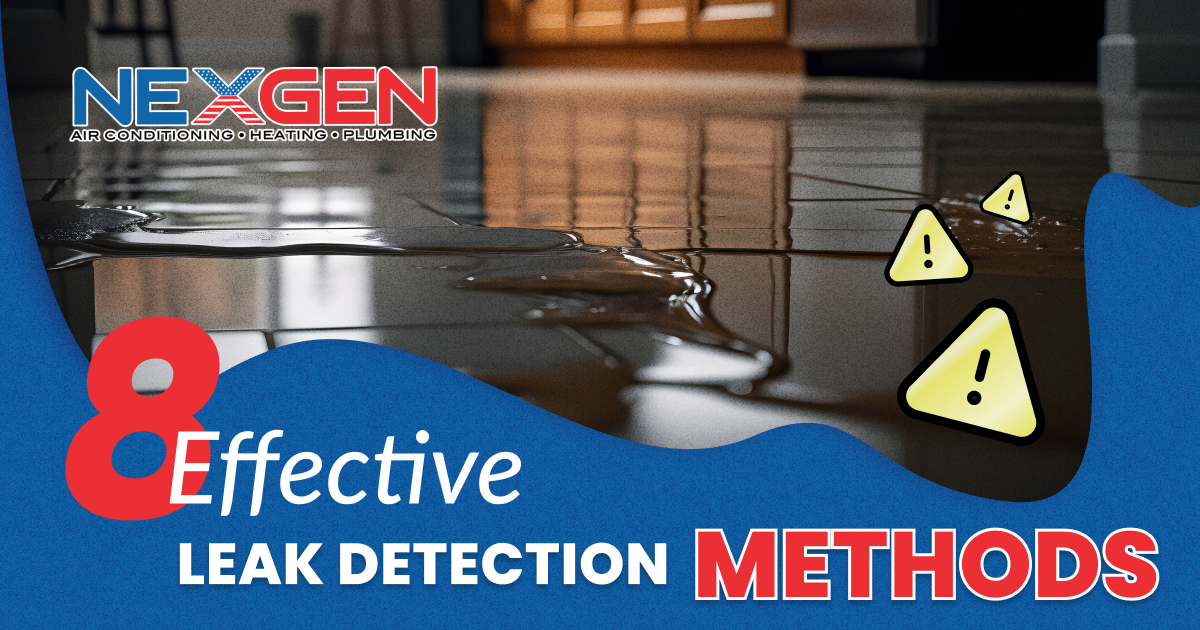
Customers in Southern California rely on NexGen for leak detection and repair. Our plumbers employ advanced leak detection methods to find water, gas, or refrigerant leaks. The method used for leak detection depends on the type of leak suspected, the size of the system, how much water is used, and what’s currently known about the problem.
Here are a few common methods used for accurately finding leaks:
- Thermal Imaging: A thermal imaging camera detects temperature changes and displays a map of temperature variations on a screen. Whether it’s hot or cold, leaking water is typically a different temperature than its surrounding environment. Therefore, a thermography camera can find leaks behind walls, under floorboards, and even within concrete. It can also detect varying amounts of moisture where there shouldn’t be, with minimal disruption and no damage to property.
- Video Pipe Inspection: A video pipe inspection camera allows for leak detection via direct observation. Mounted to a long, flexible fiber optic cable, a small camera is inserted at a faucet, plumbing fixture, or other access point. The device transmits images to a monitor as the camera is moved through the system. If there’s a leak, the plumber can see it along with the cause, such as a hole, break, or disconnection. The location is also recorded so the technician can access the damaged section without unnecessary demolition.
- Acoustic Equipment: A plumber can use microphones and listening discs to determine the location of a water leak. By sensing sound, these devices can detect leaks located behind drywall, appliances, cabinets, and various furnishings in your home. When using a listening disc, a technician with headphones places the disc against a surface. The sound is amplified so one can hear running water, even if it’s underground or under brick concrete, or stone.
- Soil Probes: A drainage or sewer line leak can be difficult to locate. The leak can be in your home or under a lawn or yard. A soil probe lets a plumber hear a leak through grass or rock. The closer the probe is to the leak, the louder the sound. But the device doesn’t only help isolate the location of the problem. It can help determine the type of leak, its depth, and the best repair method.
- Soap Bubble Test: The soap solution is sprayed, brushed, or dabbed onto a suspected damaged part of a gas line. Simple and inexpensive, this leak detection method is highly sensitive. The plumber applies the soap solution to an area that’s potentially leaking. The presence of bubbles indicates a gas leak. Raising the gas pressure saves time and increases the odds of finding the problem.
- Pressure Decay Test: Gas supply lines are pressurized with dry air or nitrogen and internal pressure is monitored over time. A fast drop in pressure means there’s a significant leak. A slower drop in pressure indicates a smaller leak. There’s no leak if the pressure remains the same.
- Vacuum Decay/Pressure Rise Test: The part or line is depressurized. Once the pressure is low and stable enough, a test media is introduced and the resulting increase in pressure is measured. But this process only determines that a leak is present. Identifying the location of the leak requires using other methods.
- Refrigerant Sniffers: If a refrigerant leak is suspected, an instrument called a sniffer can detect the chemicals in the substance. Sniffers often use helium and hydrogen as tracer gases, as they have small molecules that can pass through very small leak points. This technique can be used for an air conditioner, freezer, or other type of refrigeration system.
Hire NexGen’s Leak Detection Experts
Our licensed, bonded, and insured plumbers can find a leak no matter where the damage is and whether it’s water, gas, or refrigerant. We use the latest equipment so breaking through walls, floors, or ceilings isn’t necessary. Using proven methods, we can provide leak detection and repair 24/7 and fix the damage promptly and correctly. To receive a free quote and evaluation, call (833) 729-9735 today.
8 Signs You Need a Drain Unclogging Service
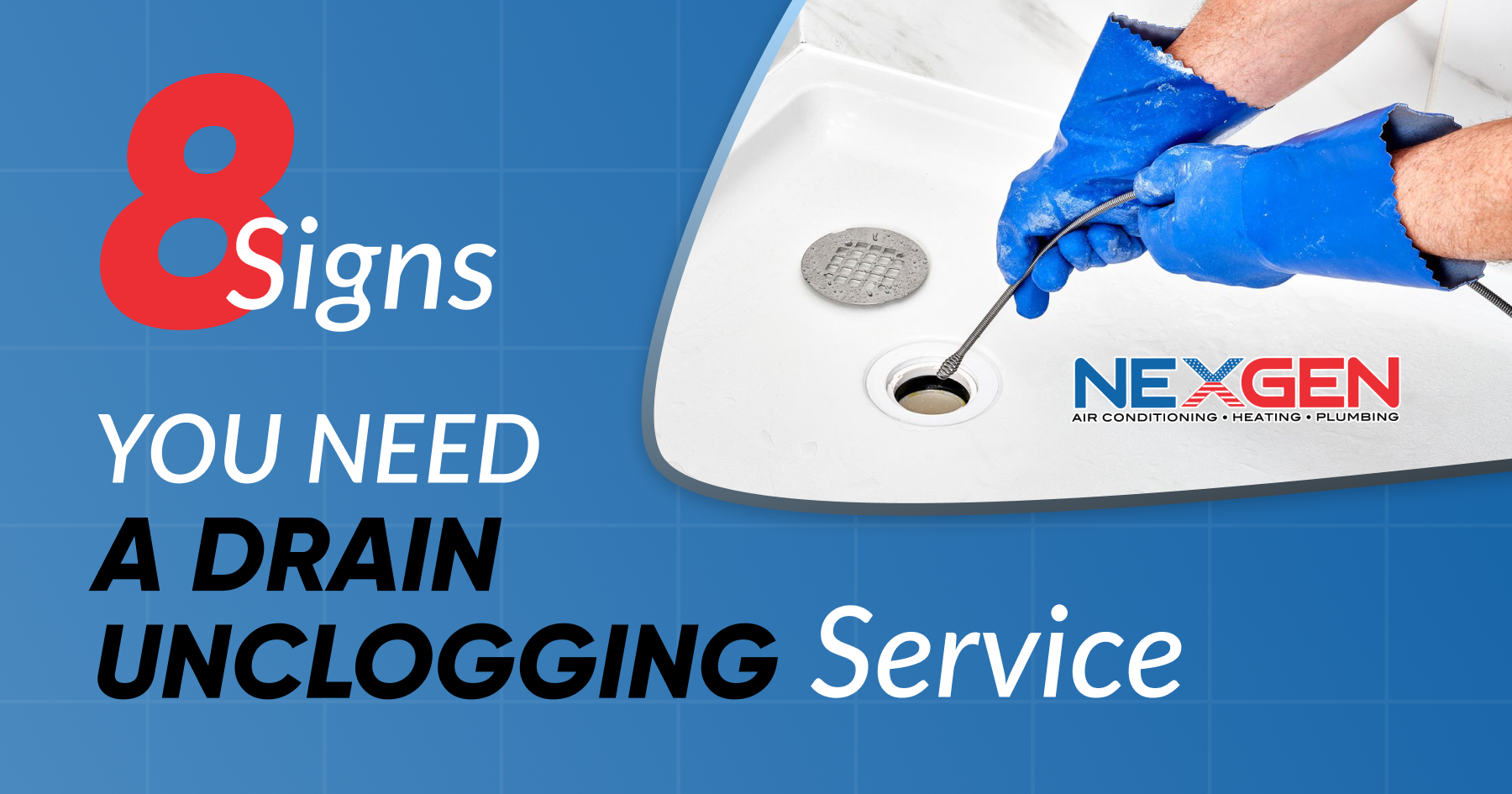
A clogged drain is one of the most common plumbing problems, and nearly everyone eventually deals with one. Sometimes you can resolve the issue with a plunger. But when do you need a professional? Here are the top 8 signs it’s time to call a drain unclogging service.
1. A Pool of Water
No matter how much you enjoy swimming and other water activities, having standing water in your home is never good. Standing water in a sink, tub, or washing machine means a drainage pipe is clogged. Dishwashers and basement floor drains can also clog. Standing water around a toilet is another reason to call for help.
2. A Slow Drain
Soap, grease, hair, and other materials build up in drains and pipes. The problem often starts gradually. Your sink or bathtub may take longer to empty. The problem will only get worse until the drain clogs up completely. So, keep an eye on those drains when you wash your hands, brush your teeth, or take a shower. If one sink or fixture is slow, the clog is probably limited to that drain; if multiple sinks slow up, there may be a sewer line blockage.
3. Clogs Occur Frequently
You cleared your sink drain a few days ago, but it clogged again. If a clog keeps recurring, a serious blockage may be forming. The standard home remedies won’t eliminate such a clog, which may be due to stubborn residue or mineral scale. You’ll need a plumber to provide a drain unclogging service to resolve the issue.
4. Your Home Smells Like Sewage
You expect your home to smell clean and fresh. If a sewer line is clogged, that familiar fresh scent is replaced by foul odors that worsen over time. Your drains may work even though food, waste, and sewage are building up inside. If the smell is coming from a rarely used sink, run the water to fill the P-trap. Otherwise, call a plumber for help. And if you have musty odors from drains, call a professional to check for and clean out any mold.
5. Pipes Are Noisy
A gurgling sound means air bubbles are forming as water pushes past a developing clog. The drain may still be working. You might also see air bubbles rising in the toilet as you run the sink faucet (indicating a possible sewer clog). The noise (and bubbles) should go away once a plumber removes what’s causing the clog.
6. Fruit Flies Are Everywhere
No food scraps are lying around, but fruit flies suddenly appear. They won’t go away no matter how well you clean the kitchen. The likely reason is food buildup in a drainage pipe. A professional plumber is equipped to remove every trace of food from the drainage line. The flies will then move on in search of other food sources.
7. Insects or Rodents in the Sink
Seeing pests in the sink is a good reason to call a drain unclogging service. Bugs and small rodents can get into drain pipes through holes and breaks. A skilled plumber can find the broken pipe, seal it, or make repairs that prevent any other pests from getting in.
8. The Water Bill Went Up
A fluctuating water bill isn’t a concern if it’s not a big change. But a dramatic increase from one month to another is a sign of a plumbing leak. While it’s more subtle than a clogged drain, it means there’s a serious problem. Have a plumber inspect your drains and pipes. They can use pipe inspection cameras to spot hard-to-find issues, fix them, and clean out your drains to prevent further problems.
Contact NexGen for Drain Cleaning Service
NexGen provides drain cleaning services in Southern California by fully licensed, insured technicians. From pipe camera inspection to drain line snaking to hydro jetting, we use the latest tools and techniques to fix clogged drains no matter what’s inside them. Whether the issue is in your sink drain or sewer line, our team will diagnose the cause and get the water flowing again. Call (833) 729-9735 to request drain unclogging service today.
Ways to Protect Your HVAC & Plumbing Systems from Heavy Rain

California has endured years of drought, but the past few months have brought one rainstorm after another. Repeated deluges have ended water restrictions for many in Southern California. But the atmospheric rivers that keep pummeling the state can do a number on home HVAC and plumbing systems. We’ll look at a few ways to protect your home from the effects of so much rain.
Ways to Protect Your HVAC System from Heavy Rain
Water can cause serious damage to your HVAC system. Air conditioners are designed to drain condensation, but their components are extremely sensitive to water exposure. The wind is also a problem as it can blow debris onto and into the condenser unit. Fortunately, there are easy ways to protect the system:
Cover the HVAC Unit
If you haven’t covered the AC unit with plywood for winter, place a plywood sheet over the top. It is effective at shielding the unit from snow and ice. If your area doesn’t see much snow, you can cover the unit with a tarp to shield it from rain and strong winds. Strap the tarp on so it doesn’t blow away. Fitting a metal or plywood cage around the air conditioner is also an option. It protects against flying debris.
Secure the Area Surrounding the Unit
Before a storm, trim trees, branches, and shrubs so they can’t fall on the AC unit. You can also plant shrubs nearby to block the wind. Exposed wires should be covered to prevent water exposure and damage from falling objects. The unit should also be anchored to a concrete pad next to a concrete or stone wall, and any loose objects nearby (toys, firewood, outdoor furniture, etc.) should be moved inside.
Install Hail Guards
Thick metal mesh hail guards should be installed before a storm hits. They don’t interfere with the unit’s heating or cooling abilities. And you avoid the unit being riddled with dents, bent fins, or damage to the coils that can prevent it from keeping your home comfortable.
Ways to Protect Your Plumbing System from Heavy Rain
Ironically, your plumbing system, which is designed to carry water, can be heavily damaged by it. Rainstorms pose an especially high risk for drains, as sediment and debris can easily clog them. Underground plumbing is also susceptible to damage by heavy wet soil and standing water. Here are some steps you can take to protect your plumbing:
Improve and Maintain Outdoor Drainage
Excessive rainwater can flood your driveway, yard, or deck and even compromise your home’s foundation. Install drains at low points on your property. And check them often for debris to clear away. Use a wet-dry vacuum to pull out debris if necessary, or install a drain guard to prevent dirt, leaves, rocks, and other items from causing blockages. Also, make sure gutters and downspouts are clear and properly installed.
Know the Signs of a Drain Problem
If your toilet starts gurgling during heavy rain, a drain is likely clogged or backing up. Your toilet may back up if rainwater has gotten into a septic tank. Clogged drains can affect municipal sewer lines as well. When this happens, dirty water can accumulate in drains and cause pipes to crack or burst. If your water looks dirty, tastes coppery, or smells like mildew or something worse, call a plumber right away.
Maintain Your Sump Pump
Sump pumps remove water from basements or the lowest part of your home. If you have a sump pump, it should turn on automatically when water reaches a certain level. At least once a year, pour some water into the sump pump basin to make sure it’s working. If it doesn’t turn on, call a plumber to inspect and repair it before the rain arrives. It will save you from a messy cleanup later on.
Call NexGen for HVAC/Plumbing Service
Whether you need AC repair or a plumber in an emergency, you can count on NexGen for prompt, effective solutions. Recent storms in California have affected many homeowners. Be on the alert for air conditioning or plumbing issues and reach out to us as soon as anything seems awry. We’ll provide repairs, drain cleaning, and inspections and address any mold or indoor air quality issues caused by recent rains. To get started, book your appointment online or call (833) 729-9735.
Should You Call a Plumber to Fix a Gas Leak?
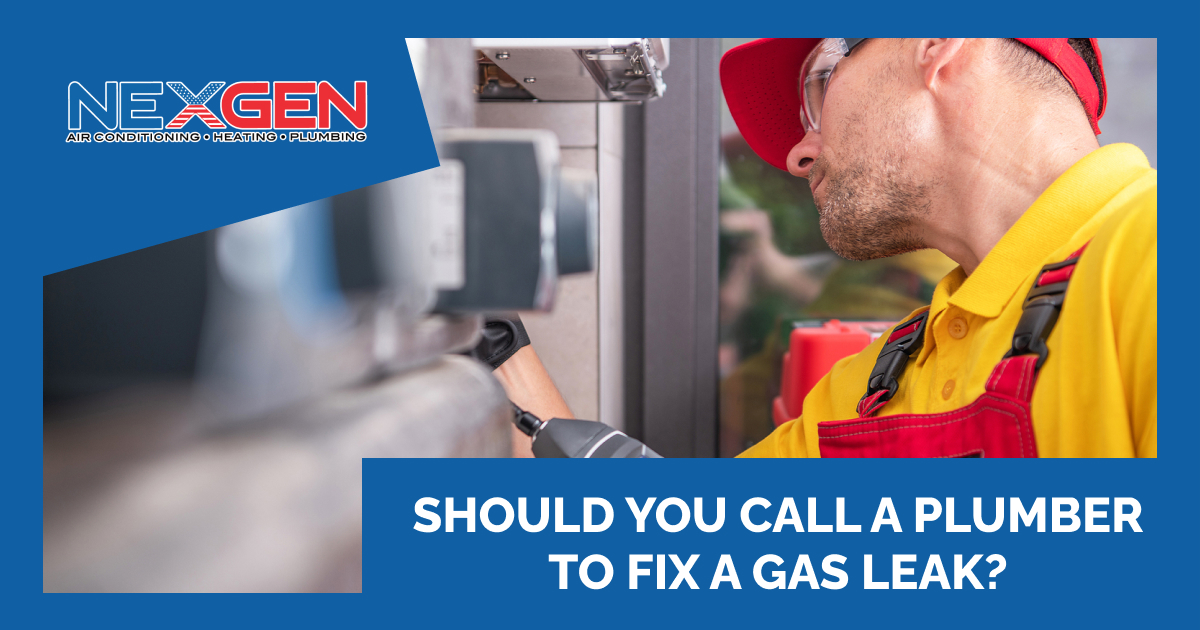
Most people associate plumbers with fixing water pipes, drains, sewer lines, and water-using appliances. A licensed plumber is also qualified to perform gas leak repair. Contact a plumbing contractor right away if you suspect a gas leak. Natural gas is flammable and a health hazard. You should call a plumber to fix a gas leak because they’re qualified to:
- Use special tools and equipment to detect gas leaks.
- Repair the damaged section of a gas pipe.
- Make adjustments that resolve or reduce the risk of leaks.
- Run gas lines from one place to another.
- Connect gas lines to appliances or fireplaces.
A Plumber Can Fix Gas Lines?
Calling a plumber might not be your first thought when you smell gas. Not every plumber can do the job. Don’t expect an apprentice or general contractor to be ready to handle the task. Check the plumber’s qualifications; they must have a California C-36 Plumbing Contractor license to work with gas lines. This means they are properly trained to fix a gas leak in your home. Working with a trained plumber will yield the following benefits:
- Safety: A licensed plumbing contractor has the tools and equipment to safely work near and fix a damaged gas line. They can quickly turn off the gas to eliminate the risk of carbon monoxide poisoning.
- Experience: Experience handling emergencies means the plumber can work calmly and methodically, and help keep everyone else calm until the problem is fixed. They’re also able to locate the source of the leak right away.
- Technical Expertise: While water and gas lines use some of the same materials, a certified plumber can determine the right pipes and materials needed. They’re also trained to correctly install gas line components, whether fixing a leak, retrofitting existing systems, or replacing old, weak, or corroded pipes.
- Installation Knowledge: Almost every property has gas appliances, but not everyone knows how to install them. A qualified technician can install a gas water heater, kitchen range, or fireplace while making sure any gas lines installed, moved, or modified are done so correctly.
- Knowledge of Rules and Codes: A licensed technician will be familiar with state and local building codes, so won’t commit any violations. Even if your jurisdiction doesn’t require it, you should still hire a technician who is properly trained in working safely around natural gas.
Signs You Need a Plumber to Fix a Gas Leak
A gas leak can come from a hole or break in the line, a damaged fitting, or a connection at an appliance. A defective appliance can leak natural gas as well. Signs of a leak include:
- Foul sulfur or rotten-egg odors.
- Hissing noises from an appliance, connection, or pipe.
- Dying house plants.
- Symptoms like nausea, dizziness, headache, fatigue, or confusion.
- An increase in gas usage/higher utility bill.
What to Do When There’s a Gas Leak
If you smell sulfur or rotten eggs, immediately turn off the gas meter. Don’t use any appliances, electronics, or devices in your home, or use matches or a lighter. Gas accumulated anywhere in your home can ignite and cause an explosion. Get everyone out of the house, including adults, children, and pets; then turn off the gas at the meter, if you can, and call an emergency plumber (or 911 and the gas company if the odor is particularly strong). Never risk trying to find and fix the problem yourself.
Any gas system issue from the meter into a home is the homeowner’s responsibility to fix. If the problem appears to be along the line before it reaches the meter, the gas company must repair it.
Call NexGen
Our technicians are trained and certified to work on gas lines, connections, and appliances. We also specialize in gas leak detection, using advanced equipment to verify a gas leak, where it is, and how much is leaking. Our team is prepared and equipped to quickly fix any leak and restore your safety. From minor adjustments to gas line replacement to 24/7 emergency service, NexGen has you covered.
Call 833-729-9735 or book an appointment online to request a plumber to fix your gas leak immediately.
How Are Your HVAC and Plumbing Systems Connected?
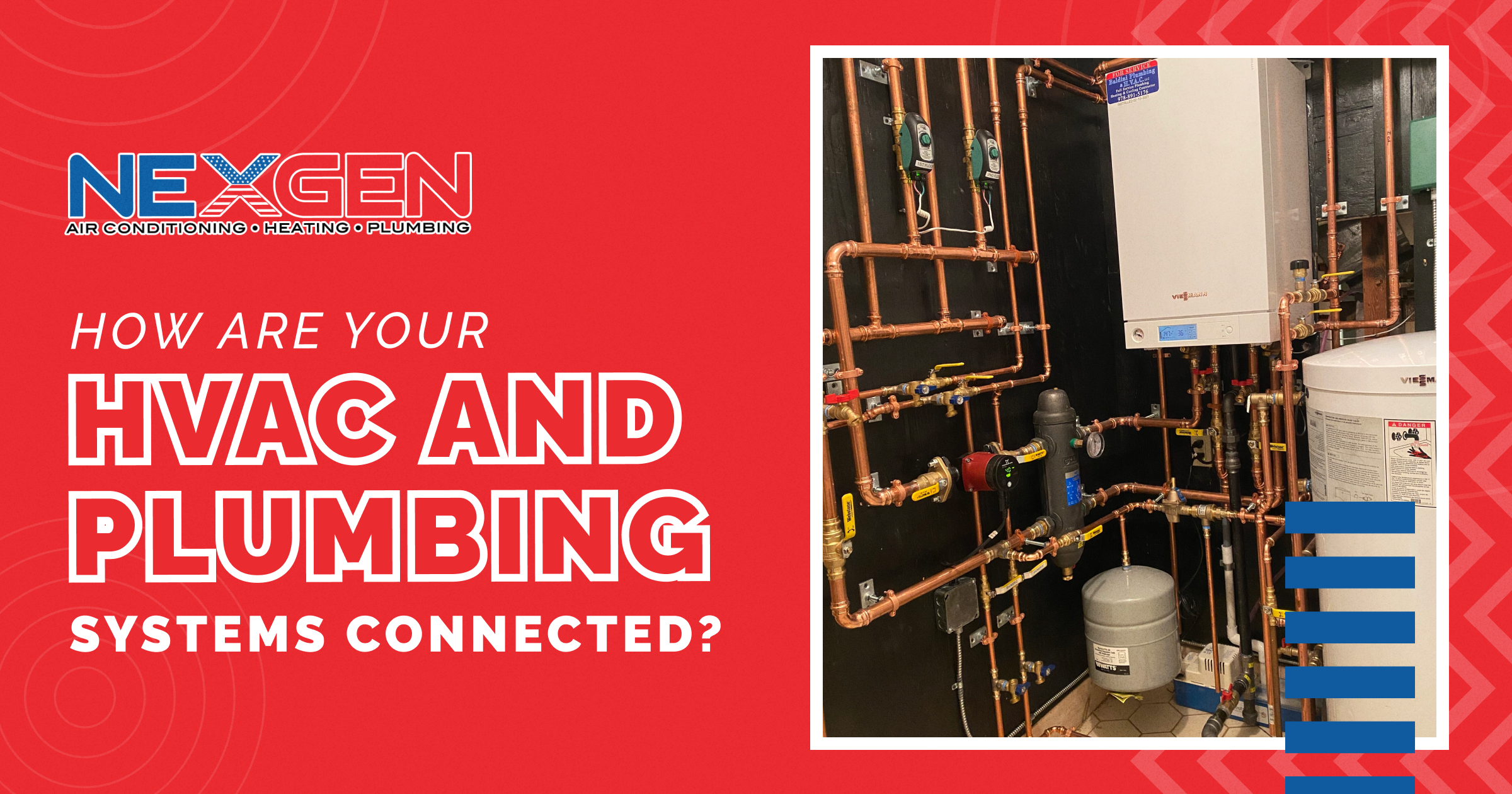
Air conditioning (HVAC), and plumbing (which involves water supply/drainage lines and connected fixtures), are two separate systems. Most people don’t realize there’s any connection between them. However, HVAC and plumbing do interact, meaning the performance of one can affect the other.
Your Central AC System Has a Drainage Line
The drainage line for your HVAC system is the most common interaction point between it and your plumbing. It collects condensate from humidity (via the condensate pan under the indoor air handler). In some systems, the condensate drainage line delivers water directly to the sewer line. But usually, condensation drains via a line through an exterior wall and to the ground. The line may also be plumbed into an upstairs sink or another part of your plumbing system.
The following issues can arise due to HVAC/plumbing drainage issues:
- For systems connected to the sewer main, a sewer line problem can cause condensation to back up, leading to water on the floor or a ceiling. Water can also potentially damage AC components.
- Water damage can occur to flooring, walls, interior ceilings, baseboards, and other elements of your home.
- Mold and/or mildew can start to grow, and then spread in colonies or through the air especially if it gets inside your HVAC system.
A condensate drain can also become clogged. This problem can be identified when you don’t see the drain dripping when the AC is on. If the condensate line and a different part of your plumbing system are both clogged, a backup can occur. For example, if the HVAC condensate drain is tied to a sink, that sink may start draining slowly.
While the condensate drain can be cleaned by pouring a half-cup of vinegar into it, don’t attempt this too often. If the drain continues to clog up, have an HVAC technician look at it. Another issue is when there’s drainage and your air conditioner is not running.
Inadequate Heating Can Impact Your Plumbing
A compressor problem, low refrigerant, or poor maintenance (leading to dirty coils, clogged filters, etc.) can affect HVAC performance. Your heating system plays a role in keeping your plumbing warm as it does the interior of rooms. If it gets cold enough in your home, pipes could potentially freeze during the winter (especially if they’re installed within exterior walls).
However, a more common issue is when the pipes in your AC system freeze. Since plumbing does not provide ventilation, it’s not going to help HVAC components warm up. If it’s too cold, pipes will continue to freeze and potentially crack and fail.
Often made of PVC tubing, condensation lines are prone to the same issues as water supply lines. They can be affected by cracks, broken joints, and ruptures. The effect is more subtle since the contents of an HVAC condensate line aren’t under pressure. Water exits a damaged line slowly and signs of an issue may develop incrementally over time.
HVAC and Plumbing Systems Both Need Maintenance and Professional Care
Different licensing and certifications are required to service either an HVAC or plumbing system. Air conditioning and heating systems need maintenance at least once or twice a year. Their mechanical nature means they’re highly prone to wear. But plumbing is always in high demand as well, and the presence of water means corrosion, clogs, or limescale can develop. A plumbing or HVAC failure can be costly to resolve. And, both are critically important to the function, comfort, and safety of your home.
Contact NexGen for HVAC/Plumbing Service
We specialize in residential and commercial HVAC and plumbing services. Customers throughout Southern California can depend on us for 24/7 emergency service and heating, air conditioning, and plumbing installation, repair, and maintenance. To get started, book an appointment online or call 833-729-9735 today.
Benefits of Sewer Camera Inspection Services
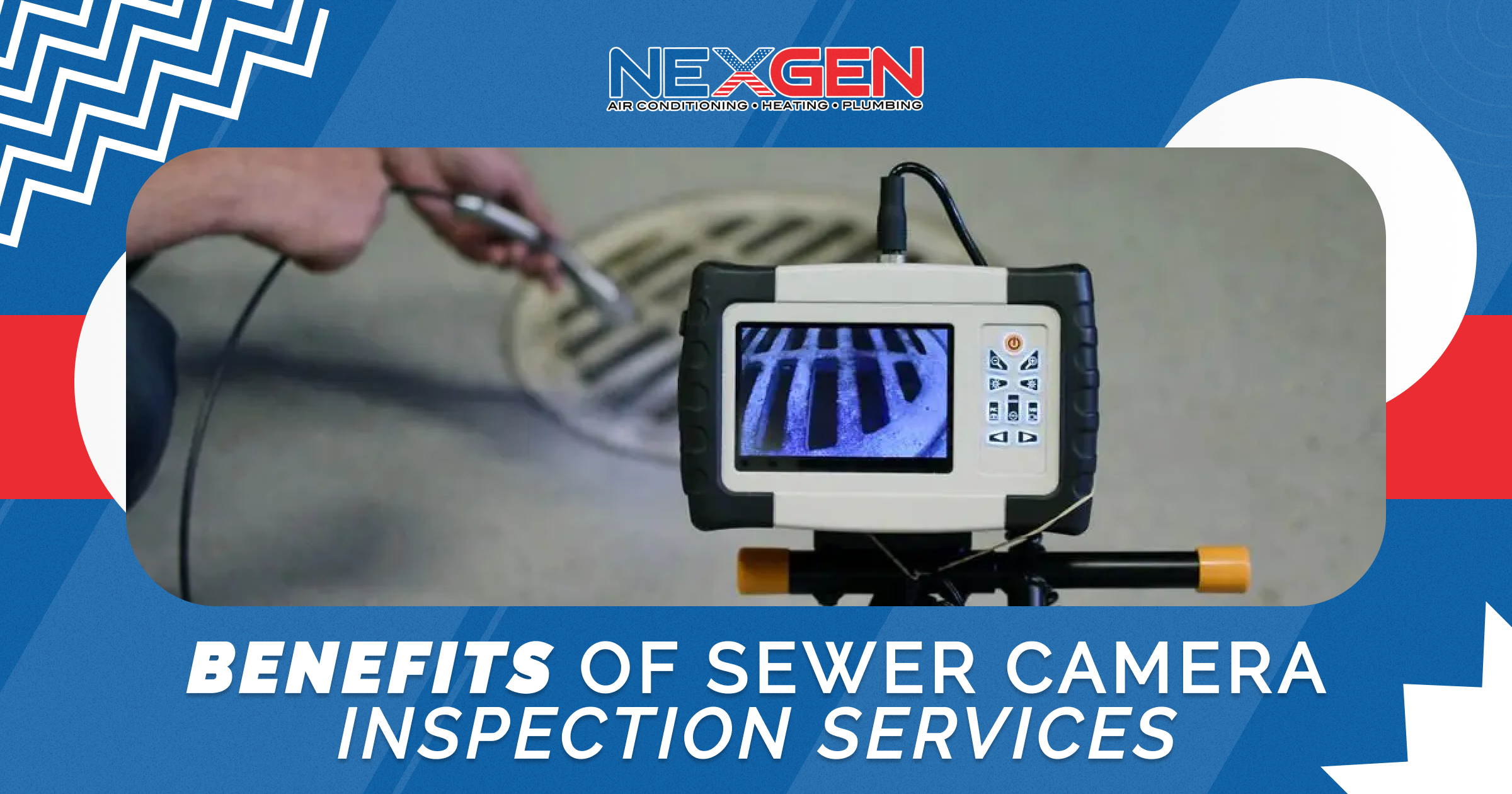
Sewer pipes are buried underground and thus hidden out of sight. Before video camera inspection, the only way to assess their condition was to excavate the ground around them. But now, whether a plumbing issue must be investigated or it’s time for maintenance, you can rely on sewer camera inspection services. A high-resolution camera, attached to a flexible cable, provides a view deep into the sewer system, in real-time.
The benefits of this process include:
No Trenching Is Required
A sewer line can be inspected without invasively digging trenches across yards and landscaping. Equipment is placed in the line via a cleanout or other access point. Once the camera begins transmitting video to a handheld monitor, the technician can immediately start assessing the condition of a pipe. Therefore, sewer camera inspection eliminates a lot of labor and saves a great deal of time.
Numerous Issues Can Be Found Quickly
Issues such as leaks, clogs, and cracked, corroded, or collapsed pipes can be identified wherever in the line they may be. Crushed, bellied, or disconnected pipes can be found as well. And if tree roots have intruded into a sewer line, they’ll be seen right away so a plumbing contractor can get started in removing them. Whatever the situation, your plumber will be able to diagnose it immediately and determine a solution to resolve it.
Property Damage Can Be Avoided
A sewer backup can flood your home with contaminated and even toxic water. Your yard or landscaping can be flooded as well. In addition to being a major health hazard, wastewater can seriously damage floors, walls, ceilings, furnishings, foundations, or anything else that’s in the way. It can introduce bacteria and harmful chemicals as well as cause mold. In extreme cases, water damage can compromise the structural integrity of your home.
It Can Determine If Trenchless Repair Methods Are Possible
A visual look at the issue allows a plumber to decide how to fix it. For example, they can tell whether inserting a pipe liner will restore the sewer line. Perhaps hydro jetting can be used to remove clogs and buildup. Trenchless methods save time and money while eliminating any further concerns over potential impacts on your home plumbing system.
Sewer Camera Inspection Services Are Affordable
The costs of digging, property repair, and extensive labor are removed. Since trenches don’t need to be dug or filled, the process is relatively quick. And because camera inspection spots issues fast, more serious issues and potential sewer line failures can be avoided. That can mean preventing future problems such as slow drains, sewage backups, water damage, and home cleanup and restoration.
A Plumber Can See Exactly What Is Blocking the Sewer Pipe
Sewer pipes can develop many kinds of blockages. Soap scum, cooking grease, trash, food items, and many other compounds can build up on pipe walls over time. Camera inspection helps spot accumulated gunk and grime so a plumber knows when to clean the pipe and avoid a major blockage. They can also determine whether it’s time to repair or replace a sewer pipe.
Contact NexGen to Schedule Sewer Camera Inspection Service
We use state-of-the-art technology to inspect sewer lines. Fiber optic cameras provide high-resolution, real-time views from inside, while the fiber optic cables we use extend for hundreds of feet. Our process is fast, accurate, and effective in helping us determine how to fix the problem, whether there’s a leak, clog, or mineral buildup. We can find its exact location and also accurately map your drainage and sewer lines.
To schedule drain and sewer camera inspection services, book an appointment online or call 833-729-9735 today.
What Equipment Is Used for Hydro Jetting Services?
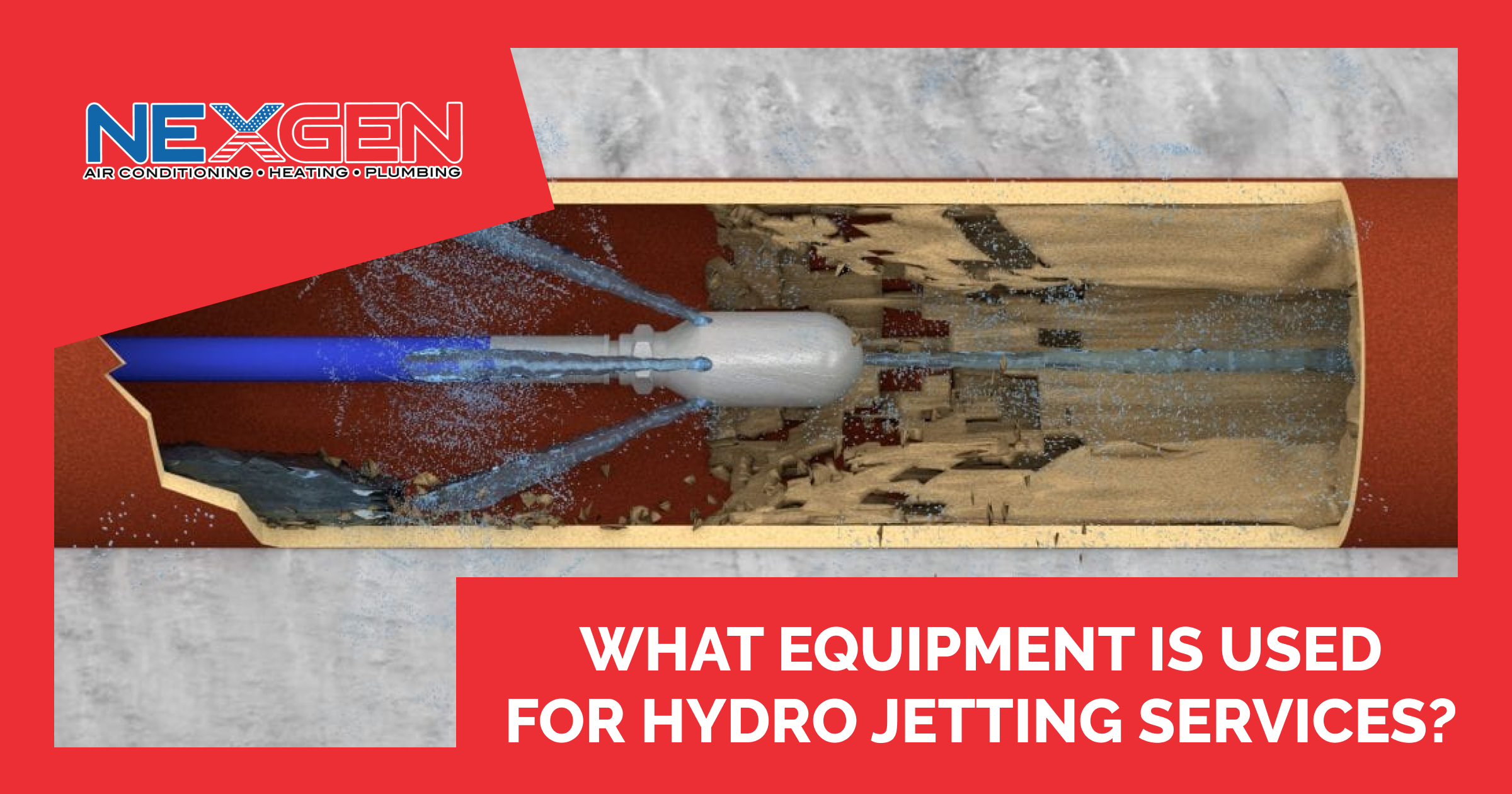
Hydro jetting is a technique that pushes high-pressure water into plumbing and sewer lines to clear blockages. As it also scours pipes clean, it can be used for preventative maintenance and clear grease, mineral scale, hair, food particles, and debris. Less debris stuck to the inside of pipes means it’s more difficult for additional material to accumulate. Hydro jetting services are typically more effective than plunging or snaking.
Here’s a look at the process and the equipment plumbers use during hydro jetting.
The Hydro Jetting Process
The jetter typically contains a water tank, hose, and nozzle. It also uses a device to pressurize water to 3,500 psi or more. There are different types of nozzles to accommodate different sizes and types of drains. Chisel-type nozzles can break through hardened clogs, ice, or tree roots. Hydro jetting is often preferred because it uses no chemicals, it’s relatively fast, and is unlikely to damage pipes. The results are long-lasting as well.
The equipment used during a hydro jetting service can include:
Hydro Jetting Engines
A hydro jetting machine can be powered by gas, diesel, or electricity and typically works with hot or cold water. Depending on the model, it may be stationary but is usually placed on a trailer pulled by a van or truck. A water jetter often has an engine/motor, pump, hose real, and water source so is often large and heavy. It is also capable of reaching deep into long drain pipes and sewer lines.
Pulse Jetter Systems
A pulsejet engine works much like a hydro-jet system. The difference is it uses pressure pulses generated by consecutive detonations inside the engine. Pulse jetters provide high compression and are therefore highly effective for sewer cleaning. Some water jetting machines and pressure washers can be converted to jetters by installing a pulsation valve; a handle lets the user achieve pulse or constant flow.
Video Inspection Cameras
Plumbers use high-resolution video cameras that attach to flexible lines, allowing them to see into sewage pipes. Technicians can find the source and location of a blockage and where to direct their hydro jetting equipment. They can also spot leaks or breaks where repairs are needed instead of high-pressure water than can worsen the problem.
Protective Equipment
Technicians performing hydro jetting services must follow safety guidelines that include wearing protective gear. You’ll likely see a hydro jetting technician wearing a safety helmet, face shield, goggles, work gloves, safety footwear, and protective overalls or jacket and trousers. Hydro jetting isn’t something just anyone can do. It requires training and familiarity with the equipment so the job can be completed safely.
Hydro Jetting Services Keep Your Plumbing in Top Shape
When debris remains stuck in pipes, it opens the door to future clogs. Blockages can build pressure in the system, which may eventually lead to burst pipes and broken sewer lines. Hydro jetting is a safe and effective process. It won’t damage pipes as long as they’re intact, even in older buildings. The process is also highly effective for high-demand plumbing, such as that in restaurants, as well as municipal pipes and commercial sewers.
Schedule a Hydro Jetting Service with NexGen
NexGen employs top-of-the-line equipment to clear drain and sewer lines. Our licensed and insured technicians are trained and experienced to complete any hydro jetting job. We’re available 24/7 to address plumbing emergencies in many Southern California locations. If your plumbing isn’t draining properly, there’s a clog, or it’s time to schedule maintenance, request hydro jetting service by calling 833-729-9735 today.
What Are the Benefits of Hydro Jetting Services?
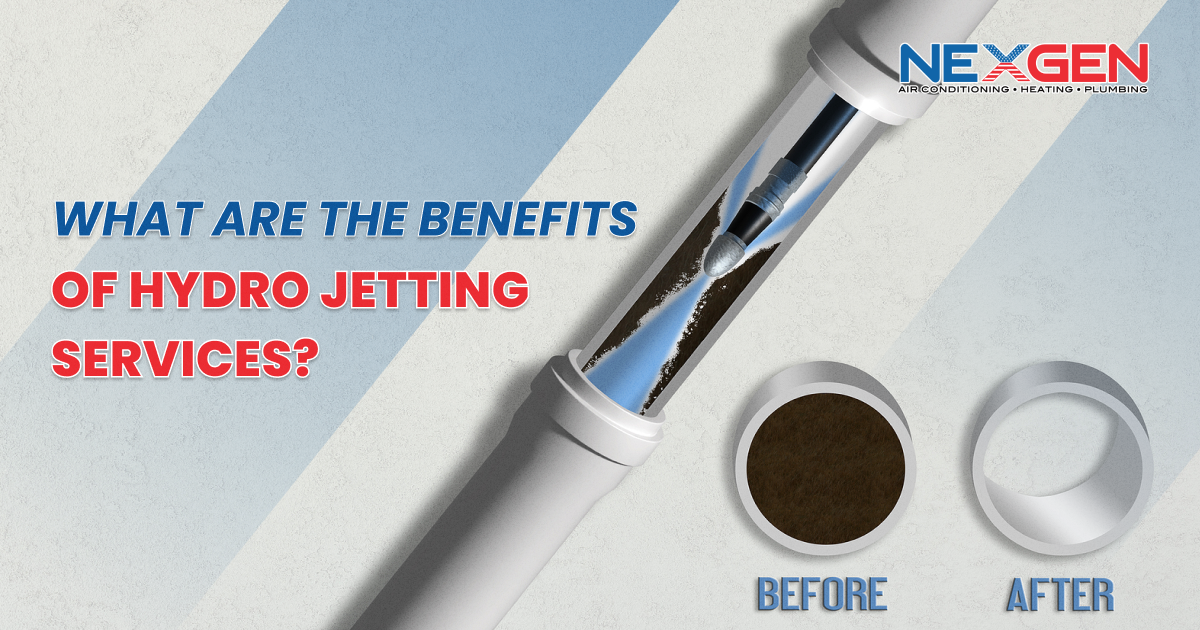
To most homeowners, plunging and snaking are more familiar methods of clearing clogged drains and blocked pipes. However, plumbers often use a process called hydro jetting. They inject water at high pressure into a plumbing or sewer line. A plumber will first use a video camera to see what’s causing the blockage. The hydro jetting machine can then be used so long as the pipe isn’t severely damaged. Here are some of the benefits of hydro jetting services:
An Extremely Thorough Cleaning
Almost any type of clog can be broken up by pressurized water. The material blocking the drain or pipe is dislodged and forced through the system. No residue is left behind that can cause another clog, and particles of any size are flushed away. Hydro jetting removes household grease, hair, paper products, sand, soil, mineral scale, tree roots, and foreign objects.
Works with Any Pipe or Plumbing System
Hydro jetting is extremely versatile and works with residential and commercial plumbing systems. It can be used with steel, cast iron, and clay pipes, as well as resin-based pipelines and cement sewer lines. Suited for jobs of any size, the process will remove blockages and also bacteria, eliminating odors and potential health hazards.
Accessibility and Convenience
Severe clogs are resolved without breaking apart walls or digging up your lawn or yard. Hydro jetting avoids expensive, time-consuming work such as digging trenches. It rarely damages pipes, so it’s safe even in older homes and can be performed in a house or via a sewer pipe cleanout. It is also more sanitary as it won’t expose the plumber or your family to sewage or debris.
Long-Lasting Results
Traditional methods of drain cleaning, including liquid drain cleaners, work only temporarily. While hydro jetting may cost more than other methods, it minimizes the odds of a drain or pipe clogging up again anytime soon. Pipe walls are scoured clean so there’s less material for debris and grime to stick to.
Cost-Savings
Professional pipe cleaning comes at a cost. Hydro jetting is more affordable and avoids repeated clogs, sewage backups, burst pipes, floods, and water damage that can end up costing you much more. Since a plumber uses a camera to spot exactly where the issue is, they can work efficiently and don’t need to open up pipes or break through walls. This saves a lot of work and drastically cuts down on the cost of service.
Safe for the Environment
Hydro jetting uses a lot of water but doesn’t introduce harmful chemicals into your plumbing system. It doesn’t risk polluting lakes, rivers, or groundwater with volatile toxins. Therefore, it protects local ecosystems as much as it does pipe and sewer lines.
Schedule Hydro Jetting Services with NexGen
Equipped with industrial-grade hydro jetting machines, NexGen’s licensed and insured technicians can clear any pipe of any type of blockage. Our process uses pressures of up to 4,000 psi to clean the insides of household pipes and sewer lines. To schedule a diagnostic camera inspection and hydro jetting service in your home or business, call 833-729-9735 today.
What Is a Septic System and How Does It Work?
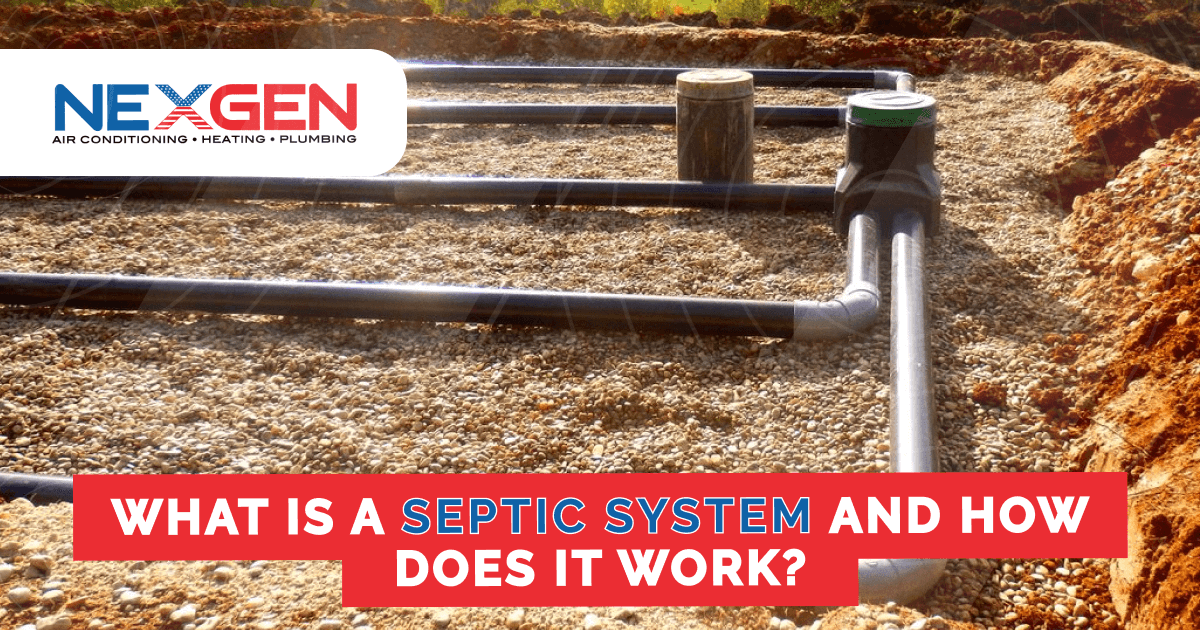
For most people who rely on utility water and waste connections, a septic system may seem like a foreign idea. But not all homes are connected to a main sewage line. In fact, millions rely on septic tanks. If you’re unfamiliar with the concept and how it works, we will now explain it in detail.
What Is Septic System?
If your home has a sewer connection, waste flushed down a toilet is piped to a sewage treatment plant, where it’s filtered from water that’s discharged into the environment once clean. Leftover waste goes to the landfill or is converted to fertilizer. A septic system works in a similar way, but on a smaller scale. Your waste is essentially treated in an underground tank just 20 to 50 feet from your house. In addition to a tank, the system consists of inlet and outlet pipes and a drain field.
How Does a Septic System Work?
The process begins as wastewater is transported via the inlet pipe from your house. It then collects in the septic tank, which typically has a 1,000-to-2,000-gallon capacity. The tank consists of two chambers; a larger chamber accepts waste that flow from the house. While solids settle at the bottom, liquids can flow over the partial wall into a smaller chamber. Wastewater is primarily moved through the system via gravity.
Anaerobic bacteria break down the solids and three layers form. Oils and grease form a top layer, while wastewater and particles form the middle layer. On the bottom are particles that are heavier than water; they form a thick layer of sludge. As solid waste is broken down, the liquids can separate and drain away, leaving behind material at the bottom that must be periodically cleaned out.
The second chamber of the septic tank has an outlet pipe. Liquid effluent flows towards the drain field through perforated pipes or plastic structures. The effluent can therefore drain into the ground, typically via a bed of gravel that helps disperse it. Remaining particles and bacteria are absorbed by the soil; the water is typically pure enough to drink once it reaches deep underground aquifers. The septic field is usually just one to two feet underground.
Do's of Maintaining Your Septic System
If your septic system isn’t properly maintained, you could have serious problems in your home. Of great importance is knowing the do’s and don’ts of maintenance, which we’ll explain below:
- Do: Inspection and Maintenance – Routine care can extend the system’s life. Gravity systems should be serviced every three years while pressure distribution systems must be maintained annually. Aerobic treatment units, membrane bioreactors, and drip irrigation systems should also be maintained annually.
- Do: Pump the Septic Tank – How often you should pump the tank depends on how much water you use. The higher the water flow, the faster the septic tank will fill. It will thus need to be pumped more frequently.
- Do: Keep Tank Lids Closed/Secured – The lid should always be closed and screwed shut. Otherwise, people could fall into it! Periodically check access lids for cracks or deterioration. Also, tank lids should be accessible; a riser makes pumping and monitoring easier.
- Do: Conserve Water – Water conservation is good for many reasons, including increasing the life of your septic system. Using too much water can make it fail prematurely.
- Do: Improve Drainage to Direct Water Away from the Drain Field – Too much water in one place can overload the drain field. It will then not work properly and can contaminate the ground or even your home.
Don’ts of Septic System Use and Maintenance
- Don’t: Flush Items Other than Toilet Paper – Paper towels, cleaning wipes, facial tissue, or even “flushable” wipes should not be flushed down the toilet. They can clog up or damage your septic system.
- Don’t: Use a Garbage Disposal – Solids and grease that pass through the disposal can build up and cause clogs in the drain field. Limit the use of your garbage disposal to as little as possible.
- Don’t: Use Drain Chemicals or Septic Tank Additives – Chemicals in household cleaners and other products kill off the bacteria that break down solids. Additives should be avoided because they add extra solids that can clog the drain field and pollute groundwater and surface water.
- Don’t: Park Vehicles on the Drain Field or Tank – Soil is compacted and pipes can break if vehicles, carports, decks, patios, storage sheds, sports courts, and landscaping elements are placed on top of the septic tank/field.
- Don’t: Drain from Hot Tubs into the Septic System – The volume of water will be too high for the drain field and chlorine can destroy helpful bacteria. Hot tubs should be drained away from all septic components.
Contact Nexgen Today
At Nexgen, we provide professional plumbing services by fully licensed and insured technicians. Serving much of Southern California, we’re relied upon for pipe, drain, water heater, garbage disposal, and septic system services. If you need more information on how a septic system works, to schedule maintenance, or request 24/7 emergency service, call us at 833-729-9735.
How to Find Your Sewer Line Cleanout
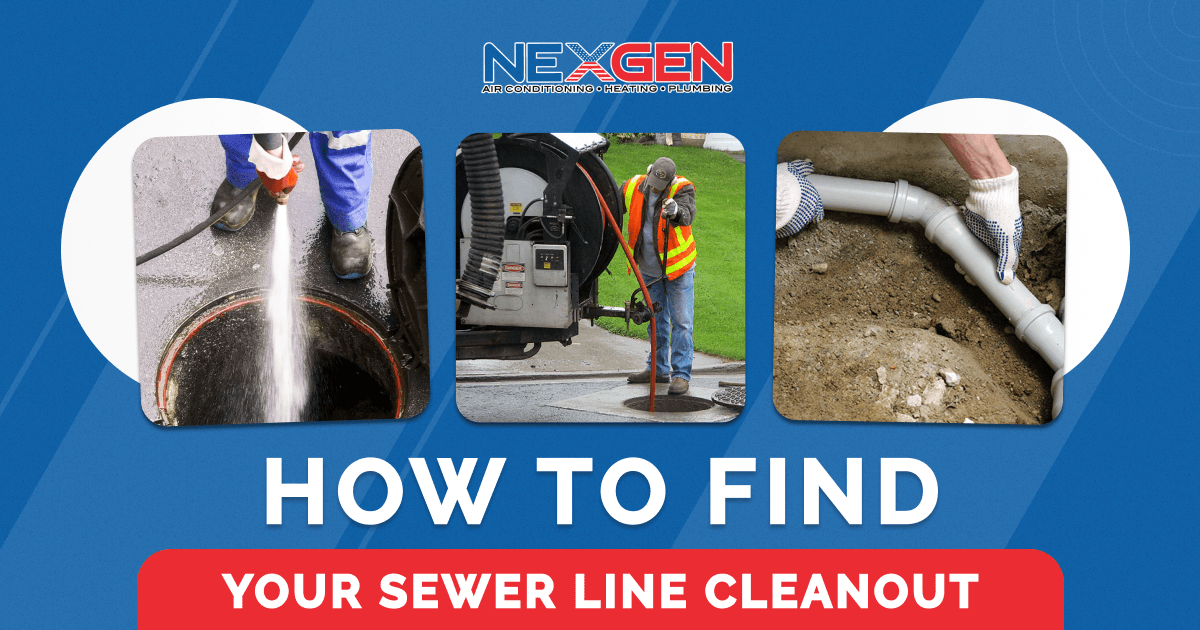
A sewer line cleanout provides direct access to the main sewer line serving your home. It may be located inside or outside your house and is primarily intended for use by plumbing professionals. If your main sewer line is clogged, or there are signs of a blockage such as multiple backed up drains, sewage coming from a floor drain, or water backing up in the shower when the toilet is flushed, the cleanout can be used to reach the source of the problem.
What Is a Sewer Line Cleanout?
It is a 3-, 4-, or 6-inch diameter pipe leading to the main sewer line. Usually white or black, this pipe is often made of ABS plastic and contains a plug and cap (in older homes, it may be made of brass or cast iron). When opened, it allows access to the main sewage line between the foundation of your home and the municipal sewer system; or, in some cases, between a septic tank and drain piping downstream of the main house trap.
Where to Look
If you live in a colder climate, a standard home often has a drain cleanout inside. However, it may be outside if the house is built on a slab foundation. Sometimes the cleanout is in a garage, utility room, or bathroom. Houses in warmer climates usually have an outdoor drain cleanout. The yard is the first place to look for it.
Finding an Indoor Drain Cleanout
Start by following the drainage pipes that lead from each sink, toilet, washing machine, or dishwasher. These may be made of ABS plastic, copper, cast iron, or bronze. The cleanout is located after where the drainage lines meet the main sewer line. It is usually in the form of a T- or Y-shaped pipe fitting, topped by a threaded plug and square nut possibly covered by a plastic cap. If the drain cleanout isn’t on the main line, then check alternate spots for a fitting with this configuration.
In homes where the sewer cleanout is not on the main line, look in areas where drainage pipes are clustered together, such as a bathroom. Use a flashlight to check in dimly lit areas that aren’t frequently accessed. If you can’t find a cleanout there, look around a utility room or garage. The cleanout may be hidden in homes that have been renovated. Contact a plumber if you’re having trouble locating the sewer line cleanout.
Finding an Outdoor Drain Cleanout
First, walk toward the municipal sewer line or septic tank. The location of the sewer line is indicated by an “S” stamped into the concrete or where the nearest manhole is. The cleanout is typically in line with the septic tank or municipal sewer system. If you use a septic system, walk back towards your home and look for a protruding plastic pipe in your lawn or garden.
If the cleanout is on the municipal sewer line, you won’t see the drainage line. But follow a path through the yard to find the cleanout pipe. It’s usually black or white and sealed with a similar threaded plug and square nut as an indoor cleanout. Check the label as well; it may say “S”, “C.O.”, or “cleanout”. Various types of plastic caps or metal lids may be used so check for anything that may be concealing a 3-, 4-, or 6-inch pipe.
Are you still having trouble finding the sewer cleanout? Look where there are drain pipe clusters or move lawn decorations or foliage outside of bathrooms. You can also try estimating where the drainage line is and poking the ground with a long screwdriver, but you’re better off with a professional’s help.
Contact a Plumber
Once you find a cleanout, whether it’s indoors or outdoors, it will need to be tested. The plug may be difficult to remove after years of disuse. And once it’s removed, raw sewage may start backing up. At Nexgen, we offer professional drain and sewer cleaning services; our technicians are licensed, trained, and prompt. They’ll arrive at your home, diagnose the problem, and access the sewer line cleanout and fix the issue for good. To request service, call 805-301-6788 or book an appointment online.


















